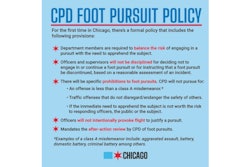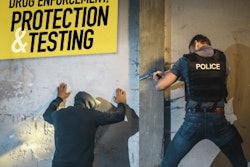![[|CREDIT|]](https://img.policemag.com/files/base/bobit/publicsafety/image/2022/01/pm.gettyimages-1310109000.jpg?auto=format%2Ccompress&fit=max&q=70&w=400)
The initiative to professionalize law enforcement agencies isn’t a new one. However, over the past two years, in the wake of protests and riots sparked by the in-custody death of George Floyd, agencies have taken a closer look at their policies and procedures in an effort to drive accountability and build stronger relationships with the communities they serve.
The benefits of professionalizing and encouraging a standard of excellence within law enforcement are vast for agencies. By leveraging the right tools and techniques, agencies can enhance training, policy development, communication, and transparency with the public. This enables agencies to focus on the day-to-day work of protecting citizens and enforcing the law, knowing they are following the right standards and procedures.
Federal funding is becoming available to support accreditation. This summer, the Department of Justice’s Office of Community Oriented Policing Services (COPS) announced the Community Policing Development (CPD) Accreditation Program, which provides resources of up to $75,000 over a two-year period to help agencies achieve accreditation for the first time.
For some agencies just getting started, it can be overwhelming to know where to begin. Laurence Van Alstine, deputy police chief for the City of Adrian, MI, has found five key elements for building a professionalized law enforcement agency.
“We started with just one piece of the puzzle, which was streamlining our accreditation process,” said Van Alstine. “Through that process, we discovered that for our operations to run more smoothly, ensuring we had the right tools to professionalize a majority of our processes—from sharing policies and procedures with the community to responding to requests for information—was critical to functioning effectively.”
Here are the five key elements to a professionalized agency:
1. Achieves and Maintains Accreditation—Accreditation can be viewed as a “blueprint of what a high functioning, professional agency should be doing. It provides your agency a proven framework to self-reflect and evaluate your policies, training, and practices against a set of standards. Many standards go a step beyond state or federal law, giving your agency and city leaders confidence you are seeking to be the best performing agency possible.
Accreditation can lead to:
• Increased Accountability
Accreditation requires that there are certain policies and training in place. It also ensures officers can access those policies easily, have read them, and understood/were trained on them. This level of accountability can help protect both the officer and agency in the event of an incident. On the flip-side, it provides documented evidence that an officer acted outside of policy, and gives supervisors the justification needed to take disciplinary action.
• Professional Excellence
Accreditation provides objective third-party validation that your agency is doing the right things and complying with the policies and procedures you implemented. An acknowledgement of excellence is much more impactful when earned via an objective third-party validation.
• Increased Support and Collaboration from Other Agencies
Accreditation creates opportunities to network with other agencies at conferences, Police Accreditation Coalitions (PACs), and onsite assessments. This creates opportunities to learn from one another, share new ideas, and ask for help when needed.
• Reduced Risk and Potential for Costly Payouts
Accreditation helps agencies operate more professionally and become better prepared for potential lawsuits. In the event of a lawsuit, the first things a plaintiff’s attorney will ask for are documentation of the alleged incident, the policy in place, and proof the officer signed and was trained on the policy.
Accreditation requires an agency to implement systems and processes that ensure all of the items requested by a plaintiff’s attorney are in place. Policy development, tracking officer acknowledgment of policies, and testing/training officers on critical policies are all part of the accreditation process. While this won’t stop the lawsuits from happening in the first place, it gives an agency the necessary tools to defend itself.
2. Creates and Maintains High-Quality Policies and Procedures—When President Donald Trump signed the Executive Order on Safe Policing for Safe Communities in 2020, he made the key point that law enforcement is a critical part of American life, but one that comes with difficult challenges.
At the same time, he stressed that agencies must grow and adapt to better serve their communities and to increase transparency, trust, and efficiency. “State and local law enforcement agencies must constantly assess and improve their practices and policies to ensure transparent, safe, and accountable delivery of law enforcement services to their communities,” Trump said.
Law enforcement policies and procedures play an essential role in this process. Effective policies equip your officers with the training and know-how to respond appropriately to difficult situations. That, in turn, helps officers perform safe policing.
3. Openly Shares Information with the Public—Transparency and trust are essential for government and public safety to create an effective and strong community. In fact, many states have laws mandating that certain documents such as policies and procedures have to be made available to the public.
By making policies accessible to the public, you are better informing them about how police respond, and why. That creates a stronger degree of trust and connection that will keep everyone safer.
“In 2020, we were getting so many requests for policies and procedures,” says Van Alstine. “People wanted to see the policies that our department had.”
Because of the time and resources required to post the documents, and keep them up to date, Alstine leveraged an existing software tool to extend the Adrian Police Department’s policies to the public. “Now that department policies are public-facing and online, we can simply direct community members to the website when we get requests. It has been a game changer in terms of time and transparency.”
4. Has Systems and Technology to Hold Officers Accountable—Like any organization, every law enforcement agency needs a strong, healthy work culture to operate effectively.
A culture of accountability in law enforcement is of particular importance. Police accountability ensures that officers can work together effectively. They can trust their commanders to make ethical decisions. They know their fellow officers will put the needs of the department and the public ahead of personal interests.
A culture of accountability in law enforcement also builds trust between the police and the community. When the public sees that law enforcement has systems in place to enforce police accountability, they are more likely to see police as legitimate. And therefore, they will be more willing to assist the police.
There are several different structures and layers of accountability in police work. But lasting accountability in law enforcement begins with fostering a department culture that values integrity and ethics.
Police departments need to create a system of internal checks and balances to make sure officers carry out their duties properly and act with integrity. The evolution of cloud technology has provided for the development of several solutions to meet this need, making it easier than ever for agencies to create a culture of accountability.
At a time when budgets are tighter, the right solutions enable agencies to maximize their resources and easily monitor and implement new policies, combine hands-on training with new, online approaches, and more effectively manage accreditation.
5. Looks for Opportunities for Continuous Improvement—A professionalized law enforcement agency places a high value on continuous improvement, whether it is through streamlining operations to become a more effective agency, or by building trust and confidence between the police and the public.
Effective policies and procedures, including the manual as a whole, are living documents that must grow and adapt with an agency. While the core elements and the intent of a policy will likely remain the same—keeping people, equipment, assets, and information safe, for example—the details of how to make it happen need to adapt to the changes in law enforcement.
An ever-evolving social media landscape is a great example of this. Social media has great potential and opportunity for law enforcement to use it to their advantage. For example, many agencies are able to share their policies more transparently with the public through Facebook and other online communities. However, social media also presents the need for additional layers of policy around how law enforcement professionals use and share information via social media.
Regular policy review and revision are an important part of every policy and procedure management plan, and it’s something an agency should put time, energy, and resources into.
Libby Bevin is a communications specialist for PowerDMS (www.powerdms.com), a cloud-based policy and compliance management platform used by thousands of law enforcement agencies to reduce risk and liability, protect reputation, increase efficiency, and promote accountability. www.linkedin.com/in/elizabeth-libby-bevin.











